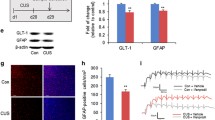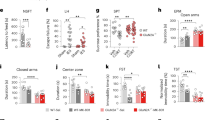Abstract
Accumulating evidence indicated that N-methyl-d-aspartate (NMDA) receptors are involved in the pathophysiology of depression and implicated in therapeutic targets. NMDA antagonists, such as ketamine, displayed fast-onset and long-lasting antidepressant activity in preclinical and clinical studies. Previous studies showed that Yueju pill exerts antidepressant effects similar to ketamine. Here, we focused on investigating the association of acute and lasting antidepressant responses of Yueju with time course changes of NMDA receptor subunits NR1, NR2A, and NR2B expressions in the hippocampus, a key region regulating depression response. As a result, Yueju reduced immobility time in the forced swimming test from 30 min to 5 days post a single administration. Yueju acutely decreased NR1 and NR2B protein expression in the hippocampus, with NR2A expression unaltered. NR1 expression remained down-regulated 5 days post Yueju administration, whereas NR2B returned to normal level in 24 h. Yueju and ketamine similarly ameliorated the depression-like symptoms at least for 72 h in learned helplessness test. They both reversed the up-regulated expression of NR1 in the learned helpless mice 1 or 3 days post administration. Different from ketamine, the antidepressant effects of Yueju were not influenced by blockade of amino-3-hydroxy-5-methyl-4-isoxazole propionate receptor. These findings served as preclinical evidence that Yueju may confer acute and long-lasting antidepressant effects by favorably modulating NMDA function in the hippocampus.




Similar content being viewed by others
References
Calabrese F, Guidotti G, Molteni R, Racagni G, Mancini M, Riva MA (2012) Stress-induced changes of hippocampal NMDA receptors: modulation by duloxetine treatment. PloS One. doi:10.1371/journal.pone.0037916
Cull-Candy SG, Leszkiewicz DN (2004) Role of distinct NMDA receptor subtypes at central synapses. Sci STKE 2004:re16
Dwyer JM, Lepack AE, Duman RS (2012) mTOR activation is required for the antidepressant effects of mGluR(2/3) blockade. Int J Neuropsychopharmacol 15:429–434
Dybała M, Siwek A, Poleszak E, Pilc A, Nowak G (2008) Lack of NMDA–AMPA interaction in antidepressant-like effect of CGP 37849, an antagonist of NMDA receptor, in the forced swim test. J Neural Transm 115:1519–1520
Fang XQ, Xu J, Feng S, Groveman BR, Lin SX, Yu XM (2011) The NMDA receptor NR1 subunit is critically involved in the regulation of NMDA receptor activity by C-terminal Src kinase (Csk). Neurochem Res 36:319–326
Ferrari AJ, Somerville AJ, Baxter AJ, Norman R, Patten SB, Vos T, Whiteford HA (2013) Global variation in the prevalence and incidence of major depressive disorder: a systematic review of the epidemiological literature. Psychol Med 43:471–481
Frankle WG, Lerma J, Laruelle M (2003) The synaptic hypothesis of schizophrenia. Neuron 39:205–216
Hassani FV, Naseri V, Razavi BM, Mehri S, Abnous K, Hosseinzadeh H (2014) Antidepressant effects of crocin and its effects on transcript and protein levels of CREB, BDNF, and VGF in rat hippocampus. Daru 22:16
Kantrowitz J, Javitt DC (2012) Glutamatergic transmission in schizophrenia: from basic research to clinical practice. Curr Opin Psychiatry 25:96–102
Kelly JP, Wrynn AS, Leonard BE (1997) The olfactory bulbectomized rat as a model of depression: an update. Pharmacol Ther 74:299–316
Li N, Lee B, Liu RJ, Banasr M, Dwyer JM, Iwata M, Li XY, Aghajanian G, Duman RS (2010) mTOR-dependent synapse formation underlies the rapid antidepressant effects of NMDA antagonists. Science 329:959–964
Lindholm JS, Autio H, Vesa L, Antila H, Lindemann L, Hoener MC, Skolnick P, Rantamaki T, Castren E (2012) The antidepressant-like effects of glutamatergic drugs ketamine and AMPA receptor potentiator LY 451646 are preserved in bdnf(+)/(-) heterozygous null mice. Neuropharmacology 62:391–397
Liudagger, Shu-Ling (2011) Anti-depressive activity of Gardeniae fructus and geniposide in mouse models of depression. Afr J Pharm Pharmacol 5:1580–1588
Maeng S, Zarate CA Jr, Du J, Schloesser RJ, McCammon J, Chen G, Manji HK (2008) Cellular mechanisms underlying the antidepressant effects of ketamine: role of alpha-amino-3-hydroxy-5-methylisoxazole-4-propionic acid receptors. Biol Psychiatry 63:349–352
Martínez-Turrillas R, Del Río J, Frechilla D (2005) Sequential changes in BDNF mRNA expression and synaptic levels of AMPA receptor subunits in rat hippocampus after chronic antidepressant treatment. Neuropharmacology 49:1178–1188
Nowak G, Ordway GA, Paul IA (1995) Alterations in the N-methyl-d-aspartate (NMDA) receptor complex in the frontal cortex of suicide victims. Brain Res 675:157–164
Palucha A, Pilc A (2007) Metabotropic glutamate receptor ligands as possible anxiolytic and antidepressant drugs. Pharmacol Ther 115:116–147
Papakostas GI, Fava M, Thase ME (2008) Treatment of SSRI-resistant depression: a meta-analysis comparing within- versus across-class switches. Biol Psychiatry 63:699–704
Pilc A, Chaki S, Nowak G, Witkin JM (2008) Mood disorders: regulation by metabotropic glutamate receptors. Biochem Pharmacol 75:997–1006
Porsolt RD, Le Pichon M, Jalfre M (1977) Depression: a new animal model sensitive to antidepressant treatments. Nature 266:730–732
Pryce CR, Azzinnari D, Spinelli S, Seifritz E, Tegethoff M, Meinlschmidt G (2011) Helplessness: a systematic translational review of theory and evidence for its relevance to understanding and treating depression. Pharmacol Ther 132:242–267
Salvadore G, Singh JB (2013) Ketamine as a fast acting antidepressant: current knowledge and open questions. CNS Neurosci Ther 19:428–436
Sanacora G, Zarate CA, Krystal J, Manji HK (2008) Targeting the glutamatergic system to develop novel, improved therapeutics for mood disorders. Nat Rev Drug Discov 7:426–437
Steru L, Chermat R, Thierry B, Mico JA, Lenegre A, Steru M, Simon P, Porsolt RD (1987) The automated tail suspension test: a computerized device which differentiates psychotropic drugs. Prog Neuropsychopharmacol Biol Psychiatry 11:659–671
Tang J, Xue W, Xia B, Ren L, Tao W, Chen C, Zhang H, Wu R, Wang Q, Wu H, Duan J, Chen G (2015) Involvement of normalized NMDA receptor and mTOR-related signaling in rapid antidepressant effects of Yueju and ketamine on chronically stressed mice. Sci Rep 5:13573
Wei X, Xu X, Shen J, Wang Z (2009) Antidepressant effect of Yueju ethanol extract and its constituents in mice models of despair. China Pharm 20:166–168
Wu R, Zhu D, Xia Y, Wang H, Tao W, Xue W, Xia B, Ren L, Zhou X, Li G, Chen G (2015) A role of Yueju in fast-onset antidepressant action on major depressive disorder and serum BDNF expression: a randomly double-blind, fluoxetine-adjunct, placebo-controlled, pilot clinical study. Neuropsychiatr Dis Treat 11:2013–2021
Xue W, Zhou X, Yi N, Jiang L, Tao W, Wu R, Wang D, Jiang J, Ge X, Wang Y, Wu H, Chen G (2013) Yueju pill rapidly induces antidepressant-like effects and acutely enhances BDNF expression in mouse brain. Evid Based Complement Alternat Med 2013:184367
Zarate CA Jr, Singh JB, Quiroz JA, Jesus GD, Denicoff KK, Luckenbaugh DA, Manji HK, Charney DS (2006) A double-blind, placebo-controlled study of memantine in the treatment of major depression. Am J Psychiatry 163:153–155
Zarate CA Jr, Brutsche NE, Ibrahim L, Franco-Chaves J, Diazgranados N, Cravchik A, Selter J, Marquardt CA, Liberty V, Luckenbaugh DA (2012) Replication of ketamine’s antidepressant efficacy in bipolar depression: a randomized controlled add-on trial. Biol Psychiatry 71:939–946
Zhang H, Xue W, Wu R, Gong T, Tao W, Zhou X, Jiang J, Zhang Y, Zhang N, Cui Y, Chen C, Chen G (2015) Rapid antidepressant activity of ethanol extract of Gardenia jasminoides ellis is associated with upregulation of BDNF expression in the hippocampus. Evid Based Complement Alternat Med 2015:761238
Acknowledgments
This study was supported by the Priority Academic Program Development of Jiangsu Higher Education Institutions (PAPD), the Natural Science Foundation of Jiangsu Province (Grant Nos. BK20140962, BK20151568), the Natural Science Foundation of Nanjing University of Chinese Medicine (Grant Nos. 12XZR03, 12XZR04), the Israel Science Foundation (ISF 738/11), and Jiangsu Province college student’s practice and innovation training (201310315007Z).
Author information
Authors and Affiliations
Corresponding author
Ethics declarations
Conflict of Interests
The authors declare no conflict of interests.
Rights and permissions
About this article
Cite this article
Xia, B., Zhang, H., Xue, W. et al. Instant and Lasting Down-Regulation of NR1 Expression in the Hippocampus is Associated Temporally with Antidepressant Activity After Acute Yueju. Cell Mol Neurobiol 36, 1189–1196 (2016). https://doi.org/10.1007/s10571-015-0316-1
Received:
Accepted:
Published:
Issue Date:
DOI: https://doi.org/10.1007/s10571-015-0316-1




